+ Open data
Open data
- Basic information
Basic information
| Entry | Database: PDB / ID: 1a73 | ||||||
|---|---|---|---|---|---|---|---|
| Title | INTRON-ENCODED ENDONUCLEASE I-PPOI COMPLEXED WITH DNA | ||||||
 Components Components |
| ||||||
 Keywords Keywords | HYDROLASE/DNA / COMPLEX (HOMING ENDONUCLEASE-DNA) / INTRON / ZINC / DNA BINDING / PROTEIN FOLDING / HYDROLASE-DNA COMPLEX | ||||||
| Function / homology |  Function and homology information Function and homology informationintron homing / endonuclease activity / Hydrolases; Acting on ester bonds Similarity search - Function | ||||||
| Biological species |  Physarum polycephalum (eukaryote) Physarum polycephalum (eukaryote) | ||||||
| Method |  X-RAY DIFFRACTION / X-RAY DIFFRACTION /  SYNCHROTRON / SYNCHROTRON /  MIR / Resolution: 1.8 Å MIR / Resolution: 1.8 Å | ||||||
 Authors Authors | Flick, K.E. / Monnat Junior, R.J. / Stoddard, B.L. | ||||||
 Citation Citation |  Journal: Nature / Year: 1998 Journal: Nature / Year: 1998Title: DNA binding and cleavage by the nuclear intron-encoded homing endonuclease I-PpoI. Authors: Flick, K.E. / Jurica, M.S. / Monnat Jr., R.J. / Stoddard, B.L. #1:  Journal: Protein Sci. / Year: 1997 Journal: Protein Sci. / Year: 1997Title: Crystallization and Preliminary X-Ray Studies of I-Ppoi: A Nuclear, Intron- Encoded Homing Endonuclease from Physarum Polycephalum Authors: Flick, K.E. / Mchugh, D. / Heath, J.D. / Stephens, K.M. / Monnat Junior, R.J. / Stoddard, B.L. | ||||||
| History |
|
- Structure visualization
Structure visualization
| Structure viewer | Molecule:  Molmil Molmil Jmol/JSmol Jmol/JSmol |
|---|
- Downloads & links
Downloads & links
- Download
Download
| PDBx/mmCIF format |  1a73.cif.gz 1a73.cif.gz | 108.3 KB | Display |  PDBx/mmCIF format PDBx/mmCIF format |
|---|---|---|---|---|
| PDB format |  pdb1a73.ent.gz pdb1a73.ent.gz | 78.6 KB | Display |  PDB format PDB format |
| PDBx/mmJSON format |  1a73.json.gz 1a73.json.gz | Tree view |  PDBx/mmJSON format PDBx/mmJSON format | |
| Others |  Other downloads Other downloads |
-Validation report
| Arichive directory |  https://data.pdbj.org/pub/pdb/validation_reports/a7/1a73 https://data.pdbj.org/pub/pdb/validation_reports/a7/1a73 ftp://data.pdbj.org/pub/pdb/validation_reports/a7/1a73 ftp://data.pdbj.org/pub/pdb/validation_reports/a7/1a73 | HTTPS FTP |
|---|
-Related structure data
- Links
Links
- Assembly
Assembly
| Deposited unit | 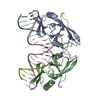
| ||||||||||
|---|---|---|---|---|---|---|---|---|---|---|---|
| 1 |
| ||||||||||
| Unit cell |
| ||||||||||
| Noncrystallographic symmetry (NCS) | NCS oper: (Code: given Matrix: (-0.970715, 0.239393, 0.020068), Vector: |
- Components
Components
-DNA chain , 2 types, 4 molecules CEDF
| #1: DNA chain | Mass: 3916.571 Da / Num. of mol.: 2 / Fragment: ENDONUCLEASE I-PPOI BINDING SEQUENCE / Source method: obtained synthetically #2: DNA chain | Mass: 2475.655 Da / Num. of mol.: 2 / Fragment: ENDONUCLEASE I-PPOI BINDING SEQUENCE / Source method: obtained synthetically |
|---|
-Protein , 1 types, 2 molecules AB
| #3: Protein | Mass: 17811.242 Da / Num. of mol.: 2 / Fragment: ENDONUCLEASE (I-PPO) ENCODED ENDONUCLEASE Source method: isolated from a genetically manipulated source Source: (gene. exp.)  Physarum polycephalum (eukaryote) / Cellular location: NUCLEUS / Plasmid: PET / Species (production host): Escherichia coli / Production host: Physarum polycephalum (eukaryote) / Cellular location: NUCLEUS / Plasmid: PET / Species (production host): Escherichia coli / Production host:  |
|---|
-Non-polymers , 3 types, 397 molecules 




| #4: Chemical | | #5: Chemical | ChemComp-ZN / #6: Water | ChemComp-HOH / | |
|---|
-Details
| Compound details | ADENOSINES |
|---|
-Experimental details
-Experiment
| Experiment | Method:  X-RAY DIFFRACTION / Number of used crystals: 1 X-RAY DIFFRACTION / Number of used crystals: 1 |
|---|
- Sample preparation
Sample preparation
| Crystal | Density Matthews: 3.4 Å3/Da / Density % sol: 60 % | ||||||||||||||||||||||||||||||||||||||||||
|---|---|---|---|---|---|---|---|---|---|---|---|---|---|---|---|---|---|---|---|---|---|---|---|---|---|---|---|---|---|---|---|---|---|---|---|---|---|---|---|---|---|---|---|
| Crystal grow | Method: vapor diffusion, hanging drop / pH: 5.6 Details: THE CRYSTALS WERE GROWN FROM A 2:1 MOLAR RATIO SOLUTION OF PROTEIN AND DNA SUPPLEMENTED WITH 2.5 MM EDTA AND 5 MM SPERMINE. THE COMPLEX WAS CRYSTALLIZED FROM 21 - 27% PEG 4000, 0.1 M ...Details: THE CRYSTALS WERE GROWN FROM A 2:1 MOLAR RATIO SOLUTION OF PROTEIN AND DNA SUPPLEMENTED WITH 2.5 MM EDTA AND 5 MM SPERMINE. THE COMPLEX WAS CRYSTALLIZED FROM 21 - 27% PEG 4000, 0.1 M CITRATE, PH 5.4 - 5.8, 20 MM NACL, 2 MM EDTA., pH 5.6, VAPOR DIFFUSION, HANGING DROP PH range: 5.4-5.8 | ||||||||||||||||||||||||||||||||||||||||||
| Components of the solutions |
| ||||||||||||||||||||||||||||||||||||||||||
| Crystal | *PLUS | ||||||||||||||||||||||||||||||||||||||||||
| Crystal grow | *PLUS Temperature: 4 ℃Details: DNA:protein solution(in 2:1 ratio) was mixed with an equal volume of reservoir solution, Flick, K.E., (1997) Protein Sci., 6, 2677. PH range low: 5.6 / PH range high: 5.4 | ||||||||||||||||||||||||||||||||||||||||||
| Components of the solutions | *PLUS
|
-Data collection
| Diffraction | Mean temperature: 100 K |
|---|---|
| Diffraction source | Source:  SYNCHROTRON / Site: SYNCHROTRON / Site:  ALS ALS  / Beamline: 5.0.2 / Beamline: 5.0.2 |
| Detector | Type: ADSC / Detector: CCD / Date: Dec 15, 1997 / Details: NONE |
| Radiation | Monochromator: DOUBLE CRYSTAL / Monochromatic (M) / Laue (L): M / Scattering type: x-ray |
| Radiation wavelength | Relative weight: 1 |
| Reflection | Resolution: 1.8→50 Å / Num. obs: 362336 / % possible obs: 99.8 % / Observed criterion σ(I): 2 / Redundancy: 5.04 % / Rmerge(I) obs: 0.049 / Rsym value: 0.049 / Net I/σ(I): 19.1 |
| Reflection shell | Resolution: 1.8→1.9 Å / Redundancy: 4.97 % / Rmerge(I) obs: 0.12 / Mean I/σ(I) obs: 4.9 / Rsym value: 0.12 / % possible all: 99.7 |
| Reflection | *PLUS Num. obs: 71892 / Num. measured all: 362336 |
- Processing
Processing
| Software |
| ||||||||||||||||||||||||||||||||||||||||||||||||||||||||||||
|---|---|---|---|---|---|---|---|---|---|---|---|---|---|---|---|---|---|---|---|---|---|---|---|---|---|---|---|---|---|---|---|---|---|---|---|---|---|---|---|---|---|---|---|---|---|---|---|---|---|---|---|---|---|---|---|---|---|---|---|---|---|
| Refinement | Method to determine structure:  MIR / Resolution: 1.8→50 Å / Cross valid method: THROUGHOUT / σ(F): 2 MIR / Resolution: 1.8→50 Å / Cross valid method: THROUGHOUT / σ(F): 2
| ||||||||||||||||||||||||||||||||||||||||||||||||||||||||||||
| Displacement parameters | Biso mean: 32.5 Å2 | ||||||||||||||||||||||||||||||||||||||||||||||||||||||||||||
| Refinement step | Cycle: LAST / Resolution: 1.8→50 Å
| ||||||||||||||||||||||||||||||||||||||||||||||||||||||||||||
| Refine LS restraints |
| ||||||||||||||||||||||||||||||||||||||||||||||||||||||||||||
| Refine LS restraints NCS | NCS model details: RESTRAINTS | ||||||||||||||||||||||||||||||||||||||||||||||||||||||||||||
| LS refinement shell | Resolution: 1.8→1.87 Å / Total num. of bins used: 10
| ||||||||||||||||||||||||||||||||||||||||||||||||||||||||||||
| Xplor file |
| ||||||||||||||||||||||||||||||||||||||||||||||||||||||||||||
| Software | *PLUS Name:  X-PLOR / Version: 3.8 / Classification: refinement X-PLOR / Version: 3.8 / Classification: refinement | ||||||||||||||||||||||||||||||||||||||||||||||||||||||||||||
| Refine LS restraints | *PLUS
|
 Movie
Movie Controller
Controller



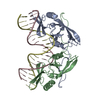
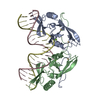
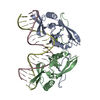



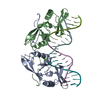

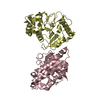

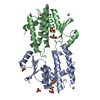
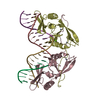
 PDBj
PDBj








































